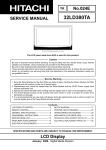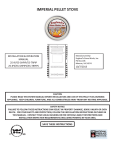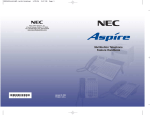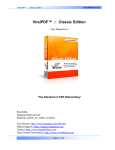Download 01-TrackingWithProsper202-Basics
Transcript
Tracking-With-Prosper202-Mechanics.pdf 1 Tracking-With-Prosper202-Mechanics.pdf Copyright ©2013 Stephen Carter. All rights reserved. No part of this work may be sold or reproduced or transmitted in any form or by any means, electronic or mechanical, including photocopying, recording or by any information storage or retrieval system, without the written permission of the copyright owner. This is not a free e-book. Purchase of this e-book entitles the buyer to keep one copy on his or her computer and to print out one copy only. Printing out more than one copy – or distributing it electronically – is prohibited by international and U.S.A. copyright laws. Cover image with permission ©2012 amyisalittledecoy Disclaimers This document should be regarded as a work of pure fiction. Certain characters, corporations, and organizations depicted in these pages are the creations of Marvel Entertainment and are used for illustrative purposes only and without any intent to describe their actual stance on the topic of tracking for the purpose of marketing. Despite the fact that this is a work of entertainment, every precaution has been taken to ensure that the information presented is accurate. However, the author shall have no any liability to any person or entity with respect to any loss or damage caused or alleged to be caused directly or indirectly by the information contained within this work. In other words… ALL CONTENT IS PROVIDED "AS IS" AND ANY AND ALL WARRANTIES ARE DISCLAIMED, WHETHER EXPRESS OR IMPLIED, INCLUDING, WITHOUT LIMITATION, ANY IMPLIED WARRANTIES OF MERCHANTABILITY OR FITNESS FOR A PARTICULAR PURPOSE. Affiliate Disclosure The author of this document may receive compensation for recommendations made in reference to products or services linked to from within these pages. Should you purchase a product or service that is recommended it is understood that some form of compensation might be made to the author. This compensation disclosure has been provided for your protection and to fully disclose any relationship that may exist between the creator of this product and the owners of the recommended products or services. IN SHORT: You have personal use rights to this product – ONLY. Please respect my rights as the copyright holder – that way I can put out more cool products. Thanks! 2 Tracking-With-Prosper202-Mechanics.pdf Table of Contents WELCOME TO VOLUME #1........................................................................................4 WHY I HOST HERE – NOT THERE................................................................................7 THE MECHANICS OF EVENT TRACKING.....................................................................9 Tracking 101 With Prosper 202.............................................................................9 How To Move Through These Pages...................................................................10 Tracking Events....................................................................................................12 The Subid.............................................................................................................13 Automating Subid Collection...............................................................................15 Method 1 – The Conversion Pixel....................................................................15 Method 2 – The Postback URL........................................................................17 Campaigns And Conversions...............................................................................18 Prosper 202 Goes To Washington.......................................................................20 #1 – TRAFFIC SOURCES....................................................................................21 #2 – CATEGORIES.............................................................................................22 #3 – CAMPAIGNS.............................................................................................23 The Direct Link Option.....................................................................................26 #7 – GET LINKS.................................................................................................27 #8 – GET POSTBACK/PIXEL..............................................................................29 The Landing Page Option.................................................................................34 #4 – LANDING PAGES.......................................................................................36 #6 – GET LP CODE............................................................................................37 #5 – TEXT ADS..................................................................................................42 #7 – GET LINKS.................................................................................................44 The Input/Output Theory Of Prosper 202...........................................................48 So, Where To From Here?...................................................................................50 3 Tracking-With-Prosper202-Mechanics.pdf WELCOME TO VOLUME #1 Thank you so much for downloading the first volume of my ad campaign tracking series. You are either going to love this product or hate it. That much I can guarantee! Either way, the information found here (especially in the later volumes) is going to make you think – hard. This is because, to be perfectly honest about it, tracking is not the easiest discipline to master. It requires critical thinking powers. Additionally, it requires the will to spend the necessary time to set things up correctly, and the patience to sift through the results of your campaigns to sort the wheat from the chaff. Allow me a moment to elaborate on these points a little further, so that you can better see where we are headed. First of all, I am going to tax your brain cells in the pages that follow. This cannot be helped. The truth of the matter is that the best campaign tracking strategies require the application of high-level cognitive powers. This is not to say you have to be a genius to be able to track your campaigns and turn a profit. Some of the most successful online marketers are managing to bring in a high return on their marketing activities using a hodge podge of tracking approaches that work for them but may not work for others. In spite of this, or because of it, I am of the opinion that a more systematic approach is better suited to a general audience because it better lends itself to extrapolation. That is to say, if you are faced with a unique situation and you have to figure out your tracking solution from scratch, having a coordinated set of tactics to draw from will more likely result in a quality tracking solution at the end of the day. 4 Tracking-With-Prosper202-Mechanics.pdf So dust off your critical thinking powers, because they will serve you well here. Next up is the matter of whether or not you have the will to put a proper tracking solution into place. Now, you may be thinking to yourself, “Don't worry. If you can show me a guaranteed way to take my money-losing campaigns and turn them into gold by throwing a proper tracking solution at them, then I'll find a way to come up with the will to get the job done!” The trouble is, I cannot guarantee you will ever make an extra dime with the approaches to tracking I am going to teach you here. For all I know you are off in search of El Dorado and no amount of effort is going to result in you reaching your destination. So in addition to the time required to get the job done, you are going to have to be willing to invest a certain amount of faith into the belief that the insights your tracking will provide you with will be worth the effort. Having said that, how many times have you heard someone say that if they had not properly tracked their results they would never have been able to attain the level of success that they currently enjoy? That is because it is true. When you add a quality tracking solution to your marketing efforts it is a lot like developing x-ray vision. Sooner or later it is going to reveal something that makes a critical difference to your return on investment. The last thing I want to mention here is the need to be patient. Even with a wellconceived tracking solution in place, you will not immediately be able to see what is working and what is not. You will need data, and a lot of it, to be sure about which campaigns need to be sidelined and which deserve to be fully scaled up and rolled out to the masses. Too often the potentially successful marketer quits a campaign because the initial numbers do not look so good. They get scared that they have embarked on yet another doomed-to-fail campaign, whereas some tweaking and careful tracking of their campaign may just turn an initially weak performer into a solid profit earner. With a little patience and the application of the ideas found in these pages, this approach has the potential to serve you well. 5 Tracking-With-Prosper202-Mechanics.pdf Wait, did I say the last thing I wanted to mention was to be patient? Well, there is something else I need to cover as well. But I will devote a separate section to it because it is just that important. It is on the subject of hosting, and I would not have bothered to include any mention of it if it was not for the fact that while writing this volume I was forced to abandon my current hosting solution and find another one. You will see why in a moment... Stephen Carter 6 Tracking-With-Prosper202-Mechanics.pdf WHY I HOST HERE – NOT THERE When it comes to the subject of web hosting, the old adage “you get what you pay for” really does not convey the full extent of the problems you will encounter when you decide to go with a cheap hosting platform. This is especially true when you are paying for traffic you intend to send to a landing page that you hope will lead to a conversion of some type that will put money back into your pocket. The trouble is that prospects are impatient. If your landing pages do not load within a second or two you will not capture their attention, no matter how good your presell material is – because they will never get the chance to see it. If your landing pages are static – which is to say they are simple HTML pages that require no database interaction – you may get away with fast page loads, even on a fairly cheap shared hosting platform. But as soon as you add a tracking solution to your setup, like Prosper 202, you move away from low server resource page loads into the realm of dynamic database interactions. This can really bog you down when it comes to load times. If you are unsure just how fast your pages are loading, use a free service to find out. For example, I recommend visiting the following page-pinging service and entering a URL from your site for which your page load time is likely to matter a great deal to its performance: http://prosper202guide.com/go/speed/ Record the load time at least half a dozen times from periods throughout the day. Is your average load time more than a few seconds? If so, you may be in trouble. The nice thing about the Pingdom service is that it presents a “waterfall” display of the load times associated with all elements on your page. So you will know precisely which parts are causing the lag. You may discover that your use of javascript is slowing down page delivery, or a large image is the real culprit. But more likely than not, it is database calls that are killing your page load speeds. 7 Tracking-With-Prosper202-Mechanics.pdf I thought my web host was doing a good job until one day I noticed a page of mine seemed to take an unusually long time to load. So I bench-marked it. This was a PPV landing page that I was tracking with Prosper 202. Load times ranged from less than a second to more than forty-five seconds. In every instance where the page took an unnecessarily long time to load it was because my web host was queuing the database queries that Prosper 202 needed to make – presumably placing them behind the database requests of other users on the server. When I discovered this I knew that my days with that web host were over. So where should you host if you are interested in using a tracking solution like Prosper 202 and you expect to ultimately be sending a lot of traffic to your offers? The solution I came up with was to use a VPS (or virtual private server) managed by Beyond Hosting. There is no special knowledge required to run your account – if you are familiar with the standard cpanel interface you already know what to expect. Now my Prosper 202 page loads are consistently around the one to two second mark. I chose Beyond Hosting because they advertise themselves as Prosper 202 web hosting experts and they are recommended by the guys who maintain the Prosper 202 software. If you think you might like to jump ship from your current web host to Beyond Hosting I have arranged a fantastic deal for you. Use the special COUPON CODE stephen-carter in combination with the link below to get 50 percent off for the first six months of hosting with the VPS Starter package: http://prosper202guide.com/go/bh/ This is an excellent offer on the part of Beyond Hosting, especially when you consider that for those first six months you may end up paying only a few dollars more per month than you are paying now for hosting that is destroying your ability to convert offers (by the way, to get this deal for you I had to agree to have my referral commission reduced to a pittance, so please use the coupon before I come to my senses and tell BH to put things back the way they were!). If you are not already using a dedicated server or a virtual private server, trust me, you will be happy that you made the change – and a lot more likely to begin seeing campaigns that convert. 8 Tracking-With-Prosper202-Mechanics.pdf THE MECHANICS OF EVENT TRACKING Tracking 101 With Prosper 202 The purpose of this volume is to teach you how to use the software application known as Prosper 202 to set up a very basic tracking solution. If I was planning to teach you how to play chess then this volume would be analogous to the session in which I introduce you to the separate chess pieces and explain how they can be moved on the board to play the game correctly. I know. Hardly sounds exciting, does it? But no-one becomes a chess grandmaster without first mastering the basics of the game. It is exactly the same with your marketing activities. You will not be able to see the repertoire of possible tracking options that are available to you unless you fully understand the “basic moves”. That means we will be spending time covering exactly what it means to set up a “direct link” tracking solution, as opposed to a “landing page” tracking solution. These concepts are basic, like the knowledge that a rook moves in an L shape across the chess board. But we will not just be talking about the basic tracking principles that need to be followed to get the job done correctly. We will be taking a close look at the implementation specifics forced upon us because we have chosen to use Prosper 202 (and no other application) to set up our tracking solution. I have settled on Prosper 202 as my tracking solution of choice because it is free to download and host on your own server. This by itself makes it a popular choice with marketers looking for a tracking solution. However, just as important is the fact that the source code for the application is not hidden from you. If you do not like the way some part of Prosper 202 works, then you can change it if you are willing to study the code and get your hands dirty with some deftly-placed edits. 9 Tracking-With-Prosper202-Mechanics.pdf Lastly, Prosper 202 is under-utilized in my opinion. I do not think the majority of people who use the application appreciate what they can and cannot do with it. In large part this is because no-one has taken the time until now to put together a resource that connects the dots and reveals that there is more to the Prosper 202 story than greets the eye. Obviously, this volume (and especially the companion volumes) represents an attempt to provide that resource. How To Move Through These Pages Sometimes you can pick up a book, peruse the table of contents, and jump to a section of immediate interest to you. Not so with this tracking series. Not unless you have already read through it entirely at least once, starting at the first volume and working your way through it sequentially. The reason for this is simple enough. In the later volumes you will sometimes find that a non-trivial component of the tracking solution which is being developed for that volume is "solved" in large part by referring you back to something which was covered in detail in an earlier volume. In other words, your ultimate tracking solution for a given project can usually be broken down into components and you can use your past experience with a simpler project to help arrive at a solution for the more complex one. Before you can hope to understand even the simplest of the tracking solutions available to you, you must first acquire a solid understanding of two things. One is what it means to “track”. The other is how that tracking is carried out at the level of the software. Now, you might be inclined to throw up your hands at this stage and say “Wait. I don't really want to know what goes on at the level of the application I'm using to perform my tracking. I just want to know how to configure the software so that I can use it. Please - Spare me the details of how it all works!” Well, that is very much like trusting you will be able to piece together a jigsaw puzzle just because you have already glimpsed the picture of the competed puzzle 10 Tracking-With-Prosper202-Mechanics.pdf on the outside of the box it came in. Sure, you very well may have an excellent idea about what the larger picture should look like when the puzzle is assembled. But unless you carefully study the shapes of the individual pieces you are unlikely to be able to piece it together in the way you had hoped. To become proficient at tracking you cannot hope to succeed merely by knowing what the final solution ought to look like and hoping you will be able to reproduce your vision within the control panels of some piece of software. No, you need a human brain to perform real tracking magic and go beyond the limitations of any single piece of software. Do not let this reality scare you. I am simply making a case for knuckling down and adopting the “back to school” approach of learning how to track from the ground up. Because unless you find yourself in the fortunate position of being able to delegate the details to someone else, you are going to need to understand how the springs and levers of the tracking assembly can be pieced together so that the final device performs as intended. Fortunately, tracking machines are much easier to build than mechanical clocks or wind up toys that march across your table top. On the other hand, this does not mean that most people who read through these pages will not simply declare in frustration that the task of implementing a tracking solution is “way more complicated than I think it probably should be!” All I can say about this is that you should try not to be that person. Instead, be the person who says to themselves “Well, this may SEEM complicated to me, but it is likely just due to the fact that I am new to these ideas and I cannot be expected to absorb everything all at once”. I suspect that even people who have been tracking campaigns for years are going to be reading through these pages and saying to themselves “Wait. Is that correct? This approach to tracking differs from the way I have been thinking about it all this time...” If that should happen, great. If you suddenly find yourself looking at your tracking solutions with an entirely different set of eyes you may soon discover 11 Tracking-With-Prosper202-Mechanics.pdf that there are better ways to measure your tracking metrics than you have been able to imagine until this point in time. If you feel you need to re-read these volumes several times over to fully grasp their meaning then re-read them. If there is any value to the content of these pages it will be measured by how often you DO refer back to them in the future. This is the best I can hope for – not that you will study the material and come away from it fully versed in the art of tracking after one reading. In the following section we will begin by briefly discussing what events can and cannot be directly detected by tracking software. The conclusions drawn are true regardless of your choice of tracking software, but do keep in mind that as the discussion becomes more concrete I will be using Prosper 202 exclusively to provide step by step instructions on how to implement any given plan of action. I also want to point out that it does not matter whether you wish to master the principles of tracking because you are an affiliate and you hope to efficiently promote products created by others, or you are a vendor promoting one or more of your own products. The principles are the same regardless of your exact position in the marketing food chain. Tracking Events At first glance you might think the events that matter in the course of a marketing campaign – from having a prospect first click on your ad or other promotional link, all the way up to the final click on the lead-acquisition or order button (either of which makes you money) – are fairly obvious. They are not. SOME of the events certainly are easy enough to understand. But the moment you decide to track results you must accept the fact that you are now in the spy business, and that the mere attempt to monitor what is going on MUST change the flow of events by introducing NEW events into the picture. For every significant “raw” interaction that takes place between the prospect and some part of your business (such as them clicking on one of your ads) the only way you can monitor the interaction is to introduce a flurry of auxiliary tracking 12 Tracking-With-Prosper202-Mechanics.pdf events that siphon off information about the raw event and store it for later analysis. Of course, all this generally happens without the prospect having the slightest notion that they are the target of your spy operation. It is like adding inaudible sound effects to each raw interaction with your prospect, and only your tracking tool is equipped with a receiver sensitive enough to pick up the signals. In my opinion the way you master the art of tracking is that you first get very familiar with the purpose and the mechanics of the auxiliary tracking events. Then it becomes almost a matter of routine to select the correct ones to apply to a given tracking scenario. I go into this subject in some depth shortly when we get to the particulars of working with Prosper 202. The Subid For the most part the results of your tracking endeavors will not depend on whether your sales or lead captures all take place on one offer network, like ClickBank or Neverblue, or they take place on a multitude of different networks. The main requirement is that each offer network offers some way to track your conversions by allowing you to pass them a “tracking ID”. This subid, as it is often called, can later be retrieved when a sale or lead capture takes place. Another option is that the offer network allows you to place a “conversion pixel” on one of their pages (such as a thank you page). This way you can record a conversion without having passed along a subid. However, the pixel method (which will be covered later) is less convenient for the offer network to deal with, and also less reliable in terms of tracking success. So subid tracking is preferable. Cost per action (CPA) networks offer subid tracking where the subid is usually an integer. The reason for this is that tracking software typically establishes a “click record” that captures information about the raw interaction between the prospect and your campaign point of entry (such as the destination link shown in a pay per click advertisement), and it identifies that record (or row) in its database with an integer record number. 13 Tracking-With-Prosper202-Mechanics.pdf Other networks offer their own form of tracking ID. For example, ClickBank allows its affiliates to send along an alphanumeric tracking ID, which it refers to as the TID value. You may be familiar with the classic ClickBank hoplink (i.e. affiliate URL): http://affiliateid.vendorid.hop.clickbank.net/?tid=something In this case, that “something” can be any string value consisting of up to 24 alphanumeric characters. So we could certainly use the TID value to send along the subid value that Prosper 202 creates when it establishes a “click record” to track the result of someone coming into our sales funnel. In the case of a CPA network the affiliate URL might look something like this: http://offernetwork.com/someofferid/youraffiliateid/?subid=something It is the same idea. We send along a prospect to view the offer and we both identify ourselves and instruct the offer network to store our tracking ID so that we can retrieve it when the prospect “converts” and we earn some money. Obviously if you fail to get your affiliate ID into the offer network reliably you are not going to get paid for those leads. Likewise, if you fail to pass along the subid you will not be able to retrieve it later and figure out which campaign paths are working for you and which are not. So no matter how involved your marketing process becomes, it is very important that you understand how to propagate your subid forward until such time as you are ready to hand the prospect off to the offer network. Sometimes this will involve you “maintaining” the subid for months on end and attaching it to every promotional link you offer your captured lead while marketing to them. This may involve storing the subid in a browser cookie (not very reliably retrieved) or embedding it into the email auto responder profile record for your lead (very reliable retrieval). Getting your subid into the offer network is one thing. Getting it out is another. 14 Tracking-With-Prosper202-Mechanics.pdf Therefore, the second conversion tracking requirement of an offer network is that they offer you a way to easily be able to extract the subids for each of the referrals you made that resulted in a commission (or a straight sale if you are the vendor of the promoted product). In the case where you are an affiliate of a ClickBank product you can visit the reporting section of your affiliate account and grab the subids associated with sales. You can then paste these subid values into the “Update” section of Prosper 202 so that the software can analyze the click records and spell out which of your promotional campaigns has made money or lost money. As to the exact definition of a “campaign” in the context of a tracking solution, we will cover that shortly. Automating Subid Collection The truth of the matter is that the process of manually updating Prosper 202 with the values of the subids that have converted is both time consuming and irritating. If you were dealing with a whole slew of offer networks and you had to visit each one daily and manually go through the task of locating the converting subids you would tire of the process very quickly. Method 1 – The Conversion Pixel The CPA networks are well aware of this inconvenience. As a result, they often allow you to specify a “conversion pixel” (a 1x1 pixel image) that can be placed on the thank you page of a given CPA vendor to instantly alert Prosper 202 to the fact that a conversion has taken place. In this context, a “thank you page” is the web page seen by the prospect immediately after they have taken the action that ensures you will get paid for referring them to the offer network. So the action may represent an actual payment for goods or services, or the prospect might have filled out a form and added themselves to someone's email list. In either case the opportunity is presented whereby a conversion pixel can be used to indicate that the desired action was taken. 15 Tracking-With-Prosper202-Mechanics.pdf In the case of the conversion pixel, no subid is actually sent back when using Prosper 202. The reason for this is that very often a financial transaction will take place on a payment server (which MAY have access to the subid) but the conversion pixel might appear on the thank you page of a vendor (on an entirely separate server) and the vendor will not necessarily have the technical know-how to embed the subid into the conversion pixel even if the subid is passed to them immediately after the payment for the product has been received. The conversion pixel is therefore said to be “static” – it does not change in any way and is completely ignorant of transactions and subids. This is not to say that the conversion pixel might not carry some information about the campaign it has been set up to track. For example, it might contain a campaign ID value. If this is the case then Prosper 202 will receive the value of the campaign ID when it is notified of a sale and use it to inspect the buyer's browser for a cookie containing a subid value associated with that campaign. Otherwise it looks for the last instance of a cookie containing a subid and uses that. It can then register the conversion by updating the click record for that subid. If it does not find a cookie it will check the prospect's IP address against its records and use the most recent subid that was created by a prospect using a computer with that same IP address. This is a concrete example of software implementation specifics that can affect our choice of how to set up a tracking solution. 16 Tracking-With-Prosper202-Mechanics.pdf So the downside to the conversion pixel approach is that it has possible points of failure (cookies can expire, or be deleted, or prospects might switch to a different browser or computer before they initiate their purchase). The one advantage the conversion pixel does have going for it is that because it is a “dumb pixel” that has no knowledge of the specifics of a particular financial transaction, it can be handed over to a vendor who can simply add it to their thank you page for the sales process. So for example, even though ClickBank (for privacy reasons) does NOT supply the vendor with the value of the affiliate's tracking ID when a sale is made, the vendor could still add the affiliate's conversion pixel to their thank you page and instruct Prosper 202 to look for the subid that resulted in the conversion. On the other hand, unless you have a close relationship with the vendor you might find it difficult to persuade them to add your conversion pixel to their thank you page. All is not lost, however, if you cannot implement the conversion pixel approach to tracking your conversions. Method 2 – The Postback URL Another option that the offer network may provide is the ability to provide them with a “postback URL”. This is a URL that points at one of your Prosper 202 tracking scripts. When the offer network accepts a postback URL it can then embed that URL into its 17 Tracking-With-Prosper202-Mechanics.pdf shopping cart (or other lead acquisition application) so that it can contact Prosper 202 at the time of a sale (or lead acquisition) and send along the value of the converting subid – even before the buyer/lead has had a chance to see the thank you page shown immediately after their purchase/opt in. This strategy is a LOT more robust than the conversion pixel method because the subid is sent along directly. There is no messing with cookies or looking up a subid based on an IP address. As already mentioned, both of these latter lookup methods can fail if the prospect “converts” from a different computer than the one from which the initial ad or email was viewed that initiated them into the sales funnel. This is ESPECIALLY the case with follow up email marketing which can take place over a period of days or even months. So if there is one KEY RULE to obey when it comes to tracking your email conversions it is this: ALWAYS implement a POSTBACK URL approach for your conversion tracking when it is available to you to use! Campaigns And Conversions In general we think of a campaign as a series of coordinated “actions” directed to achieving a specific outcome. As marketers we are probably most familiar with campaigns in the context of paid advertising, where the goal is to set up a series of ads to target a specific audience and convince them to take a particular action. The same is true of the “campaigns” we set up in Prosper 202. In this context a campaign simply represents a declaration of intent on our behalf to achieve a particular outcome. Technically it also involves the specification of a monetary worth to us if the outcome should be achieved. In practice, though, the “amount” associated with a conversion is simply used to keep tabs on whether we are spending more money trying to achieve our goals than we are managing to bring in with our campaigns. The way we keep tabs on our success rate is by tracking our “conversions”. These are well-defined user actions that either: 18 Tracking-With-Prosper202-Mechanics.pdf [1] result in the placement of a conversion pixel on a specific device that formats HTML (like a web server that presents web pages or an email client that displays messages), or [2] cause a software application to use a postback URL to notify the tracking application that the user action has taken place. So, for example, if I were to set up a campaign to encourage filthy rich patrons to make a financial contribution to my favorite political party I might give my candidate a conversion pixel to place on their thank you page – the page seen immediately after the donor makes their contribution. That way I can count how many people are willing to cough up $3500 to receive a signed copy of the candidate's election plan due solely to my own recruitment activities. These numbers are of particular interest to me because I have volunteered to help get the candidate elected and I will need to know EXACTLY how much money I managed to raise when the time comes to seek a favor in return. This is because I have a buddy, Leonard, who is a defense contractor. He is something of an oddball character, but immensely smart and one of the few people who seems to genuinely appreciate my talents. Anyway, a few weeks back he approached me about the possibility of helping him to get on the good side of the candidate. For political reasons Leonard could not be seen to be making his overture directly. But me on the other hand... Well, I am a veritable nobody, and absolutely perfect for this kind of thing. So between you and me I can tell you that we are secretly anticipating a HUGE payoff in the form of a 10-year contract to build autonomous robotic drones when our man finally takes the Oval Office... Yes siree. I am fully committed to helping usher in the Tony Stark presidency and I am prepared to enlist the help of Prosper 202 to get it done. 19 Tracking-With-Prosper202-Mechanics.pdf Prosper 202 Goes To Washington To get started we will go ahead and set up the simple campaign discussed above using Prosper 202. This will give us a chance to explore the basic interface, discuss our options, and think about what really happens between the moment a prospect sees our solicitation to make a donation, and the time they click on the candidate's Paypal order button and purchase the most expensive 4-page pamphlet I have ever had the privilege to promote. The reason we are starting with this example is that it involves no affiliate networks (and their offers) or paid traffic sources. This will allow you to see that Prosper 202 is really a very generic piece of tracking software. The only connection it has with affiliate marketing or any other money making endeavor is the one we bring to it. Before we proceed with this example I think it is worth pointing out that one of the big problems I experienced when I first began using Prosper 202 was that it seemed very ambiguous in terms of the input it wanted from me in order to set up my campaigns. Additionally, the software requires one to select options from drop down menus which, once selected, present more drop down menus to select further options. When new Prosper 202 users find themselves staring at branching options it can initially be VERY confusing. In my opinion, only when you are finally clear on the nature of the core components that have guided the development of the software will the application begin to feel intuitive to you. Until then confusion is perfectly normal. The intent of the current case study is to help you to see what these core components are so that more complex tracking discussions will become MUCH easier to follow. The first step in setting up any campaign in Prosper 202 is to visit the “Setup” area and click on the tab labeled “#1 Traffic Sources”. Before we go any further it is worth briefly discussing the navigation system in the Setup area. You will see a series of eight tabs labeled like so: 20 Tracking-With-Prosper202-Mechanics.pdf #1 Traffic Sources #2 Categories #3 Campaigns #4 Landing Pages #5 Text Ads #6 Get LP Code #7 Get Links #8 Get Postback/Pixel Often when people are discussing how to use Prosper 202 they will mention “Step #1” or “Step #7” and so on when they are referring to the eight numbered tabs above. This can give the impression that one needs to advance through the tabs one by one to set up a particular campaign. This is not the case. For example, you could specify all possible “traffic sources” and “categories” on day one and never have to visit those tabs again, no matter how many new campaigns you create from that point on (but it is unlikely). Also, not all of the tabs need to be visited when setting up a new campaign. Tabs #4, #5, #6 might be completely irrelevant for your tracking solution. Once you are familiar with the purpose of each of the tabs you will know where to go to get what you need and you will pay very little attention to the numbers on the tabs. Having said that, the numbers DO indicate the general flow of action when setting up a campaign, as the tabs with higher numbers draw information from the configuration settings specified in the tabs with lower numbers. Back to our example setup and the tab labeled “#1 Traffic Sources”. From this point on I will label the various parts of the set up discussion according to the tab we are dealing with. #1 – TRAFFIC SOURCES Every campaign is going to be associated with a source of traffic, whether it be from a paid advertising program or a strategy that involves getting free leads from somewhere. 21 Tracking-With-Prosper202-Mechanics.pdf For the purposes of this discussion you can assume that I have access to a highly trafficked political news blog (e.g. TrackingOnTheHill.com). So on the traffic sources tab I am going to specify the blog as one of my sources of traffic: Traffic Source (this is just a label to help group campaign statistics) - Tracking On The Hill Once I have saved the result I can add an “account” to associate with that traffic source. In the case of paid advertising you may have several separate accounts with a given provider, so your “account” information allows you to distinguish between them. In this case though, with my free blog leads, I simply add my name or email address to represent my account: Traffic Source - Tracking On The Hill Account Username - [email protected] You will spot another field that relates to “pixel” use on the traffic sources page, but this is an advanced option that you can ignore for now. All we want is a basic “account” available to us so that we can proceed to the next part of the campaign set up. #2 – CATEGORIES The purpose of the tab labeled “#2 Categories” is just to provide a way to group your campaigns. You can add as many categories as you like here, and name them as you see fit. In general you will probably want to name your categories so that they reflect the general goal of the campaigns you will be adding to them. Since my goal is to get Tony Stark elected as president I am going to add the following category: Category (named according to our goal) - Get Tony Stark Elected I add the category and I move on to the next tab... 22 Tracking-With-Prosper202-Mechanics.pdf #3 – CAMPAIGNS At last, the tab which allows us to specify our campaign. There is not a whole lot on this page, though. Mostly it involves specifying just where our prospect should be sent once Prosper 202 has finished interacting with them. The application refers to this final destination as the “Affiliate URL” but really it is just a drop off location, even if in most campaigns you set up as an affiliate it really will be an affiliate URL that takes the prospect to a product offer and carries with it your affiliate user ID so that you can be identified as the referrer and receive a commission if the prospect ends up purchasing the offer. In this case though, I am not an affiliate, and the place I want to send my prospect to is a campaign donation page with an order button that accepts a $3500 contribution and promises a signed copy of Tony Stark's plan to set up office in the White House. But before we look at the campaign details there is one thing you will note in the form elements that require a URL. Although in every instance Prosper 202 requires only one URL, you will see two on the example form inputs appearing in this volume. The second one, which is colored purple, is the URL you can use if you decide to copy the demo pages (found in the /demo folder of each volume) over to your server so that you can set up these campaigns yourself to see how they work. For the demo pages to work correctly you will need to edit the configuration file that accompanies these pages. It contains parameters, the editable values of which I will point out as we go along. The configuration file is found in the /demo folder and is called prosper202guide-demo-config.php As you work through the different volumes and set up more example campaigns you will be able to specify more configuration variables to implement more functionality in the demo pages. So here is how I fill out my campaign sheet (with explanation to follow): 23 Tracking-With-Prosper202-Mechanics.pdf Affiliate Network (select one of our categories from a drop down menu) - Get Tony Stark Elected Campaign Name - Gold Level Donation - $3500 Rotate Urls - No Affiliate URL - http://GetTonyStarkElected.com/donate/gold/ - http://YourDomain/demo/gettonystarkelected/donate/gold/ Payout $ (I'll use $350 rather than $3500 here – see explanation to follow) - 350 Cloaking - Off Selecting the “Affiliate Network” is easy once you appreciate that this field is badly named. It really just should say “Category” since the purpose is to have you select from one of the categories you have set up on tab “#2 Categories”. In this case we clearly want to select the category named “Get Tony Stark Elected”. Now for the campaign name. The purpose of the campaign is to get people to make a donation at the Gold Level, which costs $3500. So I have named the campaign according to that goal. On occasion you may wish to split your traffic into streams and send each to a different location. This is the reason that the “Rotate URLs” option is offered, and if you select “Yes” you will be offered several other “Affiliate URL” fields that can be filled in with alternate destination URLs for your traffic. We do not want that here, we want to send all our traffic to a single destination – the page on our candidate's web site that allows people to make a donation at the Gold Level. So for the “Affiliate URL” field we specify the URL of the donation page. Again, this URL is simply the drop off location for our traffic. You will notice that under the box that accepts our affiliate URL that there are options to add a series of 24 Tracking-With-Prosper202-Mechanics.pdf tokens to our URL. We do not need these in this example, so we will save the discussion of tokens until another example when they are needed. Payout. Tony Stark will not actually be paying me a dime for my efforts. But because I want to see how much income is generated from my efforts I would like to use a figure of $3500 for the “Payout” field. That way I will be able to see how valuable my recruitment efforts are when I visit the campaign results pages in Prosper 202. Unfortunately Prosper 202 will not allow me to exceed a value of $999.99 for the payout. Evidently the software developers failed to anticipate that the application might be used to sell some really big ticket items. So I will use $350 and remember to mentally multiply by a factor of ten when inspecting the results of the campaign. Cloaking. Prosper 202 is all about spying on your prospects to see whether they take the actions you want them to take. But at the same time the affiliate networks that you partner with to promote offers may well end up spying on you if you seem to be overly successful at delivering them traffic that converts. So the purpose of the cloaking option is to help you disguise where your traffic is coming from when you send it off to some other third party. Well, we do not really care about whether or not Tony Stark's election team can figure out where the traffic is coming from because I own the traffic source and they would not be able to cut me out of the picture and go directly to the traffic source to get the leads by themselves without my help. So we will leave cloaking off, which is the default. We will be able to deliver prospects to the donation page faster too if we leave the cloaking switched off (since the tracking software will have less work to perform). So there is less chance they will tire of waiting for the page to load and decide to spend their $3500 elsewhere. So that is our campaign fully defined in Prosper 202. Pretty darned easy to this point. From this point on though, it gets a little bit harder. Now we need to choose a monitoring strategy to actually track our traffic 25 Tracking-With-Prosper202-Mechanics.pdf as it leaves our blog and makes its way to the donation page on Tony Stark's site. We have to begin making decisions about how to proceed. This is the point at which our understanding of how Prosper 202 works behind the scenes begins to pay off – because now we can choose the right approach to setting up our tracking solution based on what is possible with the software. Of course, you might not have any idea of what that is yet. That is OK. The purpose of this example is to examine the options and spell out the consequences of using one option over another. The Direct Link Option Now that we have set up our campaign within Prosper 202 the next question is how do we incorporate it into our tracking solution? We have people going to our highly trafficked blog. We have a story on the site that is all about Tony Stark's political aspirations and how he has recently begun to wonder whether it is ethical to use the massive wealth of his innovative weapons design corporation to buy his way into the Presidency by purchasing $100 million worth of televised campaign spots. The consequence of Stark's moral dilemma is that his campaign management team has opened up a donation channel to gauge just how interested the public is in seeing their boss realize his political ambitions. I am currently sending traffic from that blog page of mine directly over to Stark's campaign donation page. This approach is known as direct linking. An alternative strategy might be to link instead to an intermediate page where I further presell people on the notion of forking over $3500 for Tony Stark's signature before I send them to the donation page. In that case I would be said to be using a landing page approach in an attempt to increase the likelihood of securing the donation. Prosper 202 recognizes this distinction and offers exactly two ways to track your prospects. One begins by sending the prospect to a “landing page” which initializes the tracking. The other involves the use of a “direct link” – the option we are considering here. 26 Tracking-With-Prosper202-Mechanics.pdf The way the “direct link” option works is that instead of linking directly from my blog to the donation page I can generate a “tracking url” that sends the prospect to a script in the Prosper 202 stable which will immediately set up a “click record” and assign a subid value to it. The prospect will then be forwarded on to the destination specified by the “Affiliate URL” we have specified for our campaign. #7 – GET LINKS To generate a tracking URL we hop over to the tab labeled “#7 Get Links” and fill out the form like so: Get Text Ad Code For - Direct Link Setup, or Simple Landing Page Setup Affiliate Network - Get Tony Stark Elected Campaign - Gold Level Donation - $3500 Method of Promotion - Direct Linking Landing Page (not relevant here) Ad Copy (not relevant here) Ad Preview (not relevant here) Cloaking (leave as is) - Campaign Default On/Off PPC Network (where is our traffic coming from?) - Tracking On The Hill PPC Account - [email protected] Max CPC (let's use one cent) 27 Tracking-With-Prosper202-Mechanics.pdf - 0.01 There really is not much in the way of options to choose here, given that we are dealing with a “direct linking” campaign. We end up selecting the values for the options that keep us connected to the “Gold Level” campaign. The only field worth spending a moment talking about is the one labeled “Max CPC” for maximum cost per click. This assumes that we can ascribe some kind of cost to us for generating each click that brings a prospect into the tracking funnel. In this case we are not paying for the traffic coming to our blog page, so we will use a small non-zero cost to keep the software happy. We will say that it costs us a cent to generate a click. For paid traffic we would provide the maximum cost per click so that Prosper 202 could use that value in the reports area to determine whether we are spending more money to buy traffic than we are generating income through sales. We will be ignoring the “costs” for this particular campaign as we are really only interested in how much money ends up in the Gold Level donation account due to our activities. When we hit the button that says “Generate Tracking Link” we are given a tracking URL that will look something like the following and make use of the dl.php (direct link) script: http://prosperdomain.com/tracking202/redirect/dl.php?t202id=3717&t202kw= You can see from this URL that the tracking ID for our Gold Level Donation campaign is 3717. [If you are following along and setting up the various demo pages and campaigns as you move through this volume you would take the t202id value generated for your own Prosper 202 demo campaign and use it for the configuration variable labeled gold_level_donation_t202id in the demo configuration file.] So instead of using this URL to link from our blog to the donation page: 28 Tracking-With-Prosper202-Mechanics.pdf http://GetTonyStarkElected.com/donate/gold/ we use the “direct link” URL provided by the software. The end result of clicking on the new link is that the prospect still ends up on the donation page, but in the split second it takes for Prosper 202 to redirect to that page it also creates a new click record, assigns a unique subid to it for identification purposes, and instructs the prospect's browser to store a cookie containing the value of that subid. We could also have arranged for the subid value to be sent along to the donation page by telling Prosper 202 to embed the value into the “Affiliate URL” just before redirecting the prospect. But in this case we are assuming there is no affiliate program associated with the donation program, so there is no need to pass along any subid – because no one would be recording it at the other end! However, we ARE interested in whether or not the prospects we are sending to the site actually go on to make a donation. So how do we get this information? We can do it by using a conversion pixel. We talked about those already. In fact this is the ONLY solution available to us here. Why? Because the other conversion tracking option we discussed, the postback URL, requires that the party hosting the “sales machine” should at the very least accept our subid, and no one over at GetTonyStarkElected.com is collecting them from us, let alone storing them so they can parrot them back to us when a donation is collected. But the conversion pixel should work OK, provided we can get someone to add the pixel to the thank you page seen by donors. Considering that we are sending them $3500 leads, this ought to be no problem at all. #8 – GET POSTBACK/PIXEL So the next thing we need to do is create the conversion pixel, which we can do by visiting the tab labeled “#8 Get Postback/Pixel”. 29 Tracking-With-Prosper202-Mechanics.pdf We fill it out like this (actually we simply accept the default options): Get Pixel Code For: - Simple Pixel (only one click can be tracked simultaneously) Secure Link: (unless your Prosper 202 resides on a secure server just ignore this option) - http:// Amount: (no need to override the default, so leave this blank) Because we are only offering the prospect who visits our blog page a single way to spend their money (through a single campaign) we can elect to use a “simple pixel”. If we had elected to use an “advanced pixel” the only difference would be that the numeric ID for the campaign would also appear in the conversion pixel. So if we were ever interested in trying to promote more than one offer with more than one campaign and wanted to do so by adding multiple promotional links on the same page, then we would definitely need to use the “advanced” version of the conversion pixel, so as to allow Prosper to track the separate campaigns at the same time. Here is what the pixel code looks like in this situation: <img height="1" width="1" border="0" style="display: none;" src="http://prosperdomain.com/tracking202/static/gpx.php?amount=" /> If the Stark campaign allowed donors to pay any amount they cared to, then we could instruct the Stark team to add the actual dollar amount to the end of the URL in the pixel before writing it to their thank you page, which is located here: http://GetTonyStarkElected.com/donate/gold/thanks.php That way our Prosper 202 conversion records would reflect the actual dollar amount collected from each donor. In this case, though, there is only one option, and that is to pay $3500. So when Prosper 202 is notified of the conversion it will 30 Tracking-With-Prosper202-Mechanics.pdf update the relevant click record with the default “payout” for our campaign – $350 (which we will interpret as $3500). You can see from the code for the conversion pixel that we are dealing with a 1x1 image pixel which is delivered using Prosper's gpx.php (global pixel) script. The script actually sends along to the donor's browser the binary code for a 1x1 GIF image and updates the relevant campaign “click record” after first figuring out which subid was floated as a cookie on the donor's browser. It is the value of the subid which is used to look up the click record that was created when the donor-to-be clicked on our tracking URL, left our blog, and went across to the donation page to make their payment. Even if they waited a day, or ten, before making their payment, so long as they use the same browser to complete the transaction, and provided our subid cookie is not deleted in the meantime, we will get credit for the donation – or at least, we will see that the subid converted in Prosper 202. How do we see that? We go over to the “Spy” section of the application and we pull up the individual subid records for the campaign in question. So in this case we select the following fields from the drop down menus: PPC Network/Account (where is the traffic coming from?) - Tracking On The Hill - [email protected] Aff Network/Campaign (where are we sending the traffic?) - Get Tony Stark Elected - Gold Level Donation - $3500 Display (let's not filter out any of the clicks just yet) - Show All Clicks When we hit the “Set Preferences” button and view the live click data (which is updated several times each minute) we see a list of all the click records (labeled by subid) that have recently been generated due to people clicking on our tracking URL. For every valid click that represents a new prospect we see a small 31 Tracking-With-Prosper202-Mechanics.pdf green circle with a plus sign embedded in it. For repeat clicks from the same user (same IP address) we will see a red circle with a minus sign. For clicks that have lead to a conversion we see a green dollar sign – meaning we are in the money. We will also see other icons representing the things that are known about the person who is being tracked, such as their browser type and whether they are on a PC or a Mac. All that really matters though is whether we can produce dollar signs in that last column. Note: If you run a campaign and you see no click data in your Spy view then no one has recently clicked on the links that contain your tracking URL (assuming of course that you have set up your links correctly). You will also see a column marked “Keyword” on the far right of the Spy view. In our case it is empty because we did not elect to associate any keyword information with our prospects. This is because we already know they are all coming from the link we placed in our blog post. But for the sake of argument, suppose we added the link to our blog post 3 times: http://TrackingOnTheHill.com/tony-stark-seeks-presidency/ Once high in the article, once in the middle, and once at the end of it. Now we ask ourselves, if we are getting conversions, are they from people who read the entire article, or are they from people who are so impatient to give that they are clicking through to the donation page as soon as they see that first link? Well, we can get an idea of the answer to this question by using the keyword field in our tracking URL. If you go back and look at it you will see there is a parameter named t202kw. This is normally used to pass keyword information associated with traffic that comes from a source of paid advertising. But we can use it here to pass information about which link in the blog post was followed. Here is our tracking URL (actually there are three of them now – one for each of the positions on the page where the link is placed), modified to tell us which link in our blog post was clicked on to get to the donation page: Tracking URL for the link at the top of the post: 32 Tracking-With-Prosper202-Mechanics.pdf http://prosperdomain.com/tracking202/redirect/dl.php?t202id=3717&t202kw=top+link Tracking URL for the link in the middle of the post: http://prosperdomain.com/tracking202/redirect/dl.php?t202id=3717&t202kw=middle+link Tracking URL for the link at the bottom of the post: http://prosperdomain.com/tracking202/redirect/dl.php?t202id=3717&t202kw=bottom+link Note that the keyword needs to be URL-encoded to appear in our URL, so the + character is used to represent a white space. If we code our tracking URLs like this then we will see keyword data appearing in our Spy view telling us where the click came from: Keyword bottom link bottom link middle link bottom link bottom link bottom link ... Apparently people who are prepared to donate $3500 to their political candidate of choice still like to read as much as they can about where their money is going before they will part with it. Does this campaign and its analysis strike you as being too trivial? If it does, that is good. It means you are following everything I am saying and you are ready for something with a little more bite. Do not worry. We shall get there. But before we conclude this example I want to change tactics and instead of using a direct link approach to send traffic from our blog to the donation page we will come at this problem from a different angle and incorporate the landing page approach to establishing a tracking solution. 33 Tracking-With-Prosper202-Mechanics.pdf The Landing Page Option To make this alternate approach to tracking the Stark donations more interesting (to avoid running the risk of boring you unnecessarily) I am going to introduce a slight complication that almost demands we implement our tracking by using Prosper 202's landing page options. Suppose we start to see some conversions taking place from our initial blog posting. We are getting some pats on the back from the guys in charge over at GetTonyStarkElected.com and they have offered us $1000 to see if we can do even better. This is not too surprising – according to Prosper 202 that first blog posting has been responsible for 12 donations, totaling $42,000. We can see this by visiting the Overview tab and clicking on the Group Overview page. Once we specify the settings associated with our campaign, and select “Keyword” as the parameter to group the results by, we see (in part) the following when we hit the “Set Preferences” button: Grand Total top link middle link bottom link Clicks 7818 Clicks 1483 2845 3490 Leads 12 Leads 0 2 10 S/U 0.15% S/U 0% 0.07% 0.29% Income $4200.00 Income $0.00 $700.00 $3500.00 Cost $78.18 Cost $14.83 $28.45 $34.90 Net $4121.82 Net $-14.83 $671.55 $3465.10 Of course, we have to keep in mind that our income (and cost) numbers are under-reported by a factor of ten, since we used a payout value of $350 when setting up the campaign. Now that we have some capital to play with (the $1000) we can afford to buy traffic. But I do not want to touch the initial blog posting which is getting organic traffic from the search engines and from an existing member base that frequents the site regularly. This time when I create a new blog post I use a plugin that allows me to delist the post from the public links on the site. The only way you can get to the page is to know the URL: 34 Tracking-With-Prosper202-Mechanics.pdf http://TrackingOnTheHill.com/stark-campaign-draws-top-level-donors/ Either that or you are one of the people that elect to click on the destination URL in the pay per click advertising campaign I will be launching on Facebook. With the initial blog post I was able to insert the tracking URL into the page three times, with the URL modified a little for each of the links so as to be able to track the position on the page the click originated from. But that is the ONLY information those links were able to provide me. They can tell me nothing else about the people who actually went on to make a donation. This time though, I want to capture as much information as I can about the donors, as well as pinpoint which of my ads struck a chord with them. The only way to do that is to load up my ad destination URL with this very same information and capture it when they click through from my ad and hit my blog post. There are two ways to do this. I could “direct link” to my blog post, in which case Prosper 202 would create the click record and capture all the information I pass to it in the tracking URL BEFORE the user even hits the blog post. After that I only need to make sure my conversion pixel for the campaign has been placed on the thank you page seen after the user makes a donation. The “direct link” approach would actually work fine here because I have yet to introduce any complications that would rule out its use (which I will do a little further along). But there is another way to set up the tracking solution where Prosper 202 does not establish the click record until AFTER the user has landed on the page. “Before, after,” you might be saying to yourself, “what's the difference?” The answer is: not much in this particular example. But we will be patient, see the example through, and then look at situations where it makes a BIG difference. Prosper 202 calls this situation, where the click record is established after the user hits the page, the “landing page” scenario. 35 Tracking-With-Prosper202-Mechanics.pdf Here is how it works. Once we have a campaign set up in Prosper 202 we can elect to create one or more “landing page” records to associate with it. Each record is based upon the URL of a web page to which we will send traffic. Prosper will use that record to provide us with some javascript code that we can insert into the web page for the purpose of generating the click record when the page is displayed. You can think of this as code to record the “incoming click”. Prosper also provides you with code to record the “outgoing click” so that the user can be tracked as they leave the page through a special link that we place on the page (in this case it would be a link that ferried the user over to the Gold Level donation page). Once again, actual conversions are recorded by placing a conversion pixel on the thank you page seen after a donor makes a payment. To see how it all works we will go through the process of setting up the landing page tracking solution. #4 – LANDING PAGES First we visit the tab labeled “#4 Landing Pages” and fill it out, specifying our blog post as the landing page: Landing Page Type - Simple (One Offer on the page) Aff Network (what category are we promoting?) - Get Tony Stark Elected Aff Campaign - Gold Level Donation - $3500 LP Nickname (this is just a label so we can easily identify the landing page) - Blog Post: Top Level Donors Landing Page URL - http://TrackingOnTheHill.com/stark-campaign-draws-top-level-donors/ - http://YourDomain/demo/trackingonthehill/stark-campaign-draws-top-level-donors/ 36 Tracking-With-Prosper202-Mechanics.pdf Once we save the data a landing page record is created and we will be able to identify it in drop down menus using the “LP Nickname” we provided above to identify the page. #6 – GET LP CODE Next we head on over to the tab labeled “#6 Get LP Code” to retrieve the javascript landing page code to be inserted into our blog post. This is the code that generates the click record when the landing page is displayed in a browser. Before we can fill out the form to generate the code we are presented with the option of selecting “Simple Landing Page” or “Advanced Landing Page”. When we are only trying to track conversions for a single campaign (here the chance to donate $3500) we want the “simple” option to generate our code: Affiliate Network - Get Tony Stark Elected Campaign - Gold Level Donation - $3500 Method of Promotion - Landing Page Landing Page - Blog Post: Top Level Donors When we click on the “Generate Tracking Link” button we are given the code to insert into the landing page. It will look something like this: <script language="JavaScript" type="text/javascript"> cbr202=Math.random()*10000000000000000; document.write('<scr'+'ipt language="JavaScript" src="http://prosperdomain.com/tracking202/static/landing.php? lpip=7165&202cb='+cbr202+'" type="text/javascript"></scr' + 'ipt>'); </script> 37 Tracking-With-Prosper202-Mechanics.pdf You will notice in the code above that there is a landing page ID present in the URL for the landing.php script that runs in the background once the landing page is loaded and generates the click record for this campaign. In this case the landing page ID is 7165. [If you happen to be setting up the demo pages/campaigns as we go along then use your own value for the landing page ID to specify the value for the variable labeled top_level_donors_landing_page_id in the demo configuration file.] This landing page code needs to be inserted into the HTML for our blog post, preferably at the bottom of the page, just above the closing body tag. In addition to the javscript landing page code we are also provided with two options for recording the “click through” from the landing page to the target page, or “Affiliate URL”, associated with our campaign. In this case it is the $3500 donation page. Before we chose which of the two options to go with, note that we could just use the URL for the donation page when providing an outgoing link in our blog post: http://GetTonyStarkElected.com/donate/gold/ But if we did that Prosper 202 would have no way of knowing that the prospect had followed our suggestion to go visit the donation page. The solution to this problem is to create an intermediate page where the click from the landing page can be recorded before the prospect is forwarded on to the final destination. So, as mentioned above, in addition to the landing page “incoming click” code, we are given “outgoing click” code that can be placed into an intermediate page. That page can either be a plain HTML web page, in which case we can paste into it the javascript code that represents the first option to record the outgoing click – or we can create a PHP web page and paste into it the PHP code that represents the second option to achieve the same goal. 38 Tracking-With-Prosper202-Mechanics.pdf In both cases we create the intermediate page, whether it be, say, redirect.html (javascript option) or redirect.php (PHP option), and we link directly to that page on our web site instead of linking to the donation page. Either way, the prospect never notices the intermediate page because in a split second Prosper 202 records the outgoing click and forwards the prospect on to the target of the campaign, which in this case is the donation page. PHP CODE FOR OUTGOING CLICK This is what the PHP code might look like for the redirect.php script if we decided to go that route (this code is provided by Prosper 202): <?php // ------------------------------------------------------------------// // Tracking202 PHP Redirection // // This PHP code is to be used for the following landing page. // http://TrackingOnTheHill.com/stark-campaign-draws-top-level-donors/ // // ------------------------------------------------------------------if (isset($_COOKIE['tracking202outbound'])) { $tracking202outbound = $_COOKIE['tracking202outbound']; } else { $tracking202outbound = 'http://prosperdomain.com/tracking202' . '/redirect/lp.php?lpip=7165&pci='.$_COOKIE['tracking202pci']; } header('location: '.$tracking202outbound); ?> In this case the HTML for the link to the donation page would something like this: 39 Tracking-With-Prosper202-Mechanics.pdf <a href="http://TrackingOnTheHill.com/stark-donations/gold/redirect.php" >Click here to donate to Tony Stark's political campaign</a> JAVASCRIPT CODE FOR OUTGOING CLICK If instead we prefer not to deal with PHP we could create a page called redirect.html, say, and use the javascript alternative provided to us: <!-- PLACE OTHER LANDING PAGE CONVERSION TRACKING PIXELS HERE --> <!-- NOW THE TRACKING202 REDIRECTS OUT --> <script type="text/javascript"> if (readCookie('tracking202outbound') != '') { window.location=readCookie('tracking202outbound'); } else { window.location='http://prosperdomain.com/tracking202/redirect/lp.php?lpip=7165'; } function readCookie(name) { var nameEQ = name + "="; var ca = document.cookie.split(';'); for(var i=0;i < ca.length;i++) { var c = ca[i]; while (c.charAt(0)==' ') c = c.substring(1,c.length); if (c.indexOf(nameEQ) == 0) return c.substring(nameEQ.length,c.length); } return null; } </script> In this case the HTML for the link from our blog post to the donation page would something like this: <a href="http://TrackingOnTheHill.com/stark-donations/gold/redirect.html">Click here to donate to Tony Stark's political campaign</a> So that takes care of the job of recording the outgoing clicks which will now show up on the “Group Overview” page in the “Overview” section of Prosper 202's 40 Tracking-With-Prosper202-Mechanics.pdf reporting area. Now we can gauge how effective our blog post is at getting people to click through to the donation page. We just look at the ratio of the outgoing to incoming clicks. We are not done yet. We need to complete two more tasks before the tracking solution is fully set up. Now that the incoming and outgoing landing page code is taken care of we will need the tracking URL to use when sending traffic to this blog post (or landing page). Remember, it is the tracking URL that will ferry to the landing page the information to be tracked, at which point that information will be captured by the landing page code we have inserted into the page. We will also need the conversion pixel. But the pixel code will be exactly the same as it was the last time we retrieved it. This is because the conversion pixel for a simple landing page, or a direct link, tracking solution does not contain any campaign specific parameters. So that leaves the tracking URL. We get it from the tab labeled “#7 Get Links” where we fill in the fields as follows: Get Text Ad Code For - Direct Link Setup, or Simple Landing Page Setup Affiliate Network - Get Tony Stark Elected Campaign - Gold Level Donation - $3500 Method of Promotion - Landing Page Landing Page - Blog Post: Top Level Donors Ad Copy (we'll ignore this option) Ad Preview (so this is irrelevant too) 41 Tracking-With-Prosper202-Mechanics.pdf Cloaking (leave as is) - Campaign Default On/Off PPC Network (where is our traffic coming from?) - Facebook Ads PPC Account - [email protected] Max CPC (let's use $1 for our cost per click estimate, but scaled down by a factor or 10) - 0.10 Notice that this time through, instead of selecting the “Direct Linking” option for the “Method Of Promotion” we selected “Landing Page” and we specified the ID of the landing page to which we will be sending traffic. Also, because we had to scale down the payout by a factor of ten (because of the $1000 limit on the maximum payout that Prosper 202 allows) the cost per click parameter is scaled down too. That way, at least, the ratio on our return on investment will be correctly calculated, even if we have to mentally scale up the income and cost numbers by a factor of ten to see what is really going on. We will get to the actual tracking URL that is generated in a moment. Before we do, there are a couple of aspects of the form that are worth a quick discussion. You will notice an option to specify the ad copy that we will be using in our paid ads. This was present before when we set up or direct link tracking URL. We ignored it then, but this time around it deserves some attention. #5 – TEXT ADS The only convenience the “Ad Copy” option offers us is that when one of our ads leads to a conversion for a particular keyword we would be able to see the actual ad copy in the reports area of Prosper 202. Besides the fact that a text ad record would have to have been set up already from the tab labeled “#5 Text Ads” (which we have not done) before it could be referenced on the “#7 Get Links” tracking URL creation page, this feature is actually rarely used because it would require us 42 Tracking-With-Prosper202-Mechanics.pdf to create a unique tracking URL for each ad that we wanted to associate with our landing page. This is way too much work for most people. It is a lot easier to create a single tracking URL and simply pass some information about the ad using the various query string parameters that are available to us when working with tracking URLs (which we will discuss shortly). So once again we ignore the “Ad Copy”. Finally there is the “PPC Network/Account” that we will be using to send the traffic to our landing page. I mentioned that we would be using the Facebook Ads platform to do this. So I would have had to first go to the tab labeled “#1 Traffic Sources” and enter the Facebook information like so: Traffic Source - Facebook Ads Account Username - [email protected] However, we shall assume that in addition to setting up our Facebook traffic source record we also set up a whole bunch of traffic source records for various PPC platforms and other forms of paid advertising. That way, whenever we need to discuss advertising with Plenty Of Fish, Google Adwords, Traffic Vance, or any of your favorite paid advertising platforms we can assume that they have already been set up and are present in the drop down menus for the field labeled as “PPC Network/Account”. You will also need to provide a value for the expected maximum cost per click for the paid advertisements. I have specified one dollar for this value, but if I later determined that this was wildly inaccurate and I wanted to change the value I would need to come back and create a new tracking URL and use that one instead to begin getting better ROI (return on investment) figures in the reports area. This is because when you edit campaign details, such as the Payout amount, the revised data only applies to tracking URLs that are generated from that point on. 43 Tracking-With-Prosper202-Mechanics.pdf This is one of the weak points of Prosper 202 and is something you need to keep in mind when you are tempted to update campaign details. #7 – GET LINKS When we go ahead and create our tracking URL on the tab labeled “#7 Get Links”, by clicking on the “Generate Tracking Link” button, we discover that it is just an augmented version of the URL we specified for our landing page record: http://TrackingOnTheHill.com/stark-campaign-draws-top-level-donors/? t202id=7729&t202kw= This is to be expected, since Prosper 202 does not enter into the tracking solution until AFTER the prospect hits the landing page. This is one of the defining characteristics of the landing page strategy that one always needs to keep in mind when thinking about ways to set up a tracking solution. This is in contrast to the direct link approach which has Prosper 202 creating the click record BEFORE depositing the prospect on the first page they see after following a tracking URL. If we are going to get the most out of using this URL we will need to inspect that tracking URL carefully and try to understand those query string parameters. First of all, we need to remember that when we are dealing with a landing page tracking solution it is the inbound javascript landing page code that we plucked from tab “#6 Get LP Code” that creates the click record in Prosper 202 once the user lands on the page. It is at this point that the landing.php script is run, and the query string parameters of the landing page tracking URL are inspected and their values embedded into the tracking record. So the value of the tracking ID variable t202id is needed to connect the click record with the correct traffic source and maximum cost per click in the reporting area. This is how we will be able to gauge the ROI (return on investment) on our ad spend. Then there is the t202kw variable which is traditionally used to pass to Propser 202 information about the keyword that triggered the ad displayed on the advertising platform we are using to send traffic to our landing page. Or in 44 Tracking-With-Prosper202-Mechanics.pdf general it can be used to indicate the source of our traffic, such as a link in an email promotion, a URL displayed in a magazine ad, and so on. If we had attached “Ad Copy” to our tracking URL record then every time we looked at subids that had converted in the reporting area we would immediately be able to see which ad was responsible and we could simply pass the keyword from our ad into Prosper 202 by making use of the t202kw value. So if we had set up an ad to be triggered when someone searched for the keyword “stark campaign progress” we would have encoded the keyword into the tracking URL like this: t202kw=stark+campaign+progress and the ad copy would be displayed along with the keyword. But as I pointed out earlier, it is much easier not to create separate tracking URLs for individual ads and instead make do with a single tracking URL and put information to identify the specific ad into the t202kw value like this: t202kw=ad1+stark+campaign+progress Now we can see at a glance that “ad number one” was the advertisement that attracted the prospect. Because when we glance at the “Keyword” column on the “Spy” or “Visitors” page in the reporting area we will see this: Keywords ad1 stark campaign progress This is extremely useful information because it allows us to figure out which ads are converting and which are simply costing us money while bringing no results. But the t202kw variable is not the only one that can be used to capture information into the click record. Four more variables were added to Prosper 202 to allow one to “slice and dice” information about the traffic source, or ad. This way, in addition to not having to cram all the information into the t202kw 45 Tracking-With-Prosper202-Mechanics.pdf variable, the subid data can be tallied and grouped according to the variables that seem the most relevant to the campaign in question. These four variables are known as the 'c' variables. If Prosper 202 encounters query string variables named 'c1', 'c2', 'c3', or 'c4', it will record their values in the click record, just as it will record the value it finds for the t202kw variable. So if we were to run an ad aimed at men 40 to 50 years of age with an annual income level between $80K and $100K we might encode the 'c' variables in our tracking URL like this: c1=ad+1&c2=men&c3=aged+40-50&c4=income+80-100K or this, perhaps: c1=ad1&c2=men&c3=ages-40-50&c4=earns-80-100K In the first instance we would see the 'c' values reported in Prosper 202 like this: c1 = ad 1 c2 = men c3 = aged 40-50 c4 = income 80-100K and in the second case, these values: c1 = ad1 c2 = men c3 = ages-40-50 c4 = earns-80-100K It is up to you to decide which method of formatting will result in the most readable records when it comes to inspecting your conversion data in the reporting area. You can specify any number of 'c' records (from the 4 available to you) when setting up your tracking URL, including specifying none of them if all you want to do is use the t202kw keyword variable to pass information about your traffic source. 46 Tracking-With-Prosper202-Mechanics.pdf One important consideration to keep in mind later when it comes to setting up more complex tracking solutions than we have seen so far is that Prosper 202 will pass the values of the 'c' variables to your “Affiliate URL”, making them available in the form of tokens represented by the placeholders [[c1]], [[c2]], [[c3]], and [[c4]] which are then replaced with the values passed in through the tracking URL. So for example, you may remember that the “Affiliate URL” for the current campaign (the place we send our traffic – the donation page) is the following: http://GetTonyStarkElected.com/donate/gold/ Now in this case we have no reason to send the Stark team any information about our campaign. But if we wanted to, we could send them all our 'c' data by writing our “Affiliate URL” like this: http://GetTonyStarkElected.com/donate/gold/? ad=[[c1]]&gender=[[c2]]&age=[[c3]]&income=[[c4]] So the 'c' values are worth understanding, since for more complex tracking solutions, as we will come up against later, you may want to pass their values on to the next stage of your tracking solution. If you are wondering why I did not add the t202kw variable to the revised affiliate URL above it is because Prosper 202 does not make this variable available to the affiliate URL. Why is this? Probably because it was deemed prudent not to make keyword information available to the offer network that you might be promoting with your ads, lest they decide to run their own ads for those keywords once they see which ones are bringing in sales. If you really did need to pass the keyword information forward in your “Affiliate URL” you could always use one of the 'c' variables to do it. So let us review what we have done. 47 Tracking-With-Prosper202-Mechanics.pdf We have set up a landing page in Prosper 202 using a new blog posting as the target. We have inserted the “incoming” landing page code into that blog post. We have also created an “outgoing redirection page” that is used to record the click through from our landing page to the target page of our campaign – which in this case is the $3500 donation page. We have also generated the tracking URL which we use to send people from our Facebook ads to that blog post. And that is it. Our tracking solution is fully set up. We have been relatively long-winded in our discussion of how to pull off all of this, but that is because we wanted to take a careful look at all of our options and make sure we understand what Prosper 202 is doing behind the scenes. This is important if we are going to be able to “see” how to construct more complex tracking solutions later. At this stage you have been exposed to ALL of the important elements that make up a tracking solution. If you have been paying attention, you now have your diploma in tracking according to Prosper 202. Everything else is just a matter of applying the rules you have learned here to more complex situations. The Input/Output Theory Of Prosper 202 Before we wrap up this volume I want to discuss tracking with Prosper 202 from a slightly different point of view than what may be presented by others. A more abstract view. The advantage of the abstract view is that it frees up your brain to build more complex tracking solutions because you have fewer preconceptions about how you can use the software. The disadvantage is that there may suddenly seem to be a lot more moving parts and there is no user manual to guide you (with, of course, the exception of Volume #2, #3, and #4). The hub of Prosper 202 is the “campaigns” page. The tab labeled “#3 Campaigns”. 48 Tracking-With-Prosper202-Mechanics.pdf In my mind it is the “input/output” page of a kind of black box – one that says “Tell me the URL to redirect to after I am activated with a click. In addition, I will record any information you send along and provide you with a subid so that you can look up the information again at a later date. Additionally, I will pass on that information in the redirected or outgoing URL, if that may be of use to you.” There is no discussion here of whether the outgoing URL is an affiliate URL or even just a URL to a sales page of some kind. It is simply a destination to which the user should be taken next. This is a convenient way to think about a campaign, because now if a campaign is just a black box with inputs and outputs it is not hard to imagine that you might want to connect the output of one box to the input of another. Why would you want to do that? To build in behavior that is not present to begin with. To ferry tracking information from one part of a tracking solution to the next part. This is how you can extend simple notions of how to track to more powerful approaches that allow one to interrogate the efficiency of more complex sales funnels. Whether you decide to go with a “direct linking” or “landing page” approach to your campaign, the basic flow of information through the black box is the same. You feed the box with a t202id value to identify the campaign and, optionally, t202kw and 'c' tracking data – and out of it (after the click record has been created) comes a subid value to identify the click record, and if you require it, the 'c' data as well. So, schematically speaking, when you launch a campaign it looks like this: 49 Tracking-With-Prosper202-Mechanics.pdf Now because the tracking data can be passed out (the 'c' values) we can combine all or a portion of it with a new t202id value and use the combination as the input to the next black box in our series. We can do this as many times as we like and even pass forward the subid value of one campaign to the next one if that benefits us in some way. In Volumes #2, #3, #4 this actually does prove useful. We can also “do things” to the output of one campaign before using it as input to another campaign. For example, we could place a “landing page rotation script” between campaigns so that a different path through the funnel is selected each time a new user goes through it. We look at that approach first in Volume #3, then again in Volume #4. We can take the subid of a parent campaign and instruct a child campaign to report back to it each time the child detects that the desired campaign action (a “lead”) has taken place. So the parent can keep a tally of what the child is up to. In Volume #2 this approach is introduced as a way to set up a “lifetime sales” campaign that monitors all transactions from a single lead for as long as they remain in the funnel – which may be some time if they are captured onto an email auto responder. So, as you can see, once you adopt the input/output point of view with your tracking application there is a whole world of possibilities that open up when it comes to thinking about how you can set up your tracking solutions. So, Where To From Here? First of all, if you have read this far, I want to congratulate you for having invested a little of your time into this subject. Event tracking is not an easy skill to master, but it is an essential one for every marketer. Now that you understand the “basic moves” for setting up tracking solutions with Prosper 202 we can move on to something a little more challenging. In Volume #2 we will take a look at a very common tracking requirement that crops up in any sales funnel which involves an email auto responder. 50 Tracking-With-Prosper202-Mechanics.pdf If you expect to be involved with email marketing for the long haul, chances are you will recognize the value of being able to answer the following questions: • How do we determine the opt in rate of squeeze pages used to gather leads? • How do we determine the profitability of each broadcast or follow up email message? • How do we determine the lifetime value of a subscriber based on the total amount of referred sales that originate with an initial promotion and continue as a result of email broadcasts and automated follow ups? The best way to develop a proper appreciation for what can and cannot be done when it comes to implementing your own tracking solutions is to study in detail the anatomy of a few non-trivial tracking solutions. In Volume #2 (found by clicking here) you will be able to do exactly this – study a “done for you” email tracking solution. On the other hand, while this kind of exercise is extremely useful, tracking solutions work best when they are tailored to your own particular sales funnel, the variations of which are literally endless. So in the end you will be faced with two options. Either you limit yourself to sales funnel designs for which tracking solutions have already been worked out by others and can simply be copied OR you apply what you have learned about the principles of tracking and you build your own tracking solutions. In practice I expect you will want to do a little of both, and hopefully what you learn in these pages will allow you to do that. Of course, I realize that most people who have read this far will take no further action. But for those who are up to the 51 Tracking-With-Prosper202-Mechanics.pdf challenge, my goal is to continually build on the tracking fundamentals developed to this point and, with the application of a bit of elbow grease, quickly transition your ability to formulate quality tracking solutions from this: to this: So, are you ready to get started? Because, trust me, you ain't seen nothing yet. ~ // ~ 52 Tracking-With-Prosper202-Mechanics.pdf Also In This Series If you enjoyed the content of this volume you may also wish to check out the two companion volumes that complete this series (found by clicking here): Volume #3 Tracking For Landing Pages When Tony Stark decides to sell spots in his elite League Of Masterminds syndicate it quickly becomes necessary to develop new tracking solutions to handle sequential and rotating landing page scenarios. But Tony is not satisfied with the results and pushes for an alternative approach. Innovation strikes after the discovery at Stark Industries of a sophisticated Taguchi algorithm which massively improves the split-testing of landing pages. Finally, Pepper Potts uncovers a serious problem. The company is on the verge of bankruptcy. Volume #4 The Ultimate CPA Strategy With Stark Industries desperately in need of cash Pepper decides to sell off the company's arc reactor inventory with a firesale. To maximize the return on investment we implement a highly optimizable lead acquisition and sales funnel that leading CPA marketers have used to increase profits by five times or more. I bring in Leonard Crane to assist me with the tracking solution and we finally discover what the nature of Tony Stark's top secret project is after we sneak into his lab. 53










































































